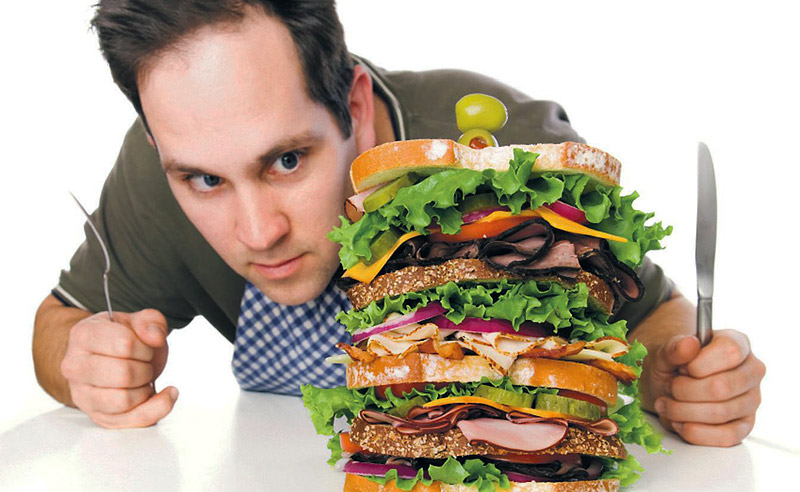
Emotional eater? Late-night snacker? At-the-table-pants-unbuttoner? If any of these describe you, these smart strategies could be just what you’ve been ~hungering~ for.
Nearly all of us harbor certain eating tendencies that risk sabotaging our best efforts to otherwise eat healthy, be active, and feel happy and in control. It may seem like it should be as easy as simply stopping the behavior, but cycles of misguided habits and frustration can turn these issues into something that’s much more difficult to amend.
“You’re not alone,” says Ashley M. Lytwyn, R.D.N. and director of nutrition at Breathe Life Healing Centers, which specializes in programs treating eating disorders, including binge eating, and food addiction. “Today’s world encourages and even rewards unhealthy eating patterns that can lead to longer-term issues,” she adds.
Here are some of the most common bad eating habits – and how to take control of your eating.
1. Needing to always feel “full” after a meal.
If you don’t consider dinnertime over until your belly is practically distended and it’s hard to stand, your idea of what it means to feel full probably means eating a lot more than your body actually needs. Think of it as the difference between packing an overnight bag for the weekend versus stuffing a suitcase with outfits you won’t even wear. Despite what you may be used to, a meal can be over before you have that unbutton-the-pants urge. Retrain your brain and body to feel satisfied with less by planning smaller meals with snacks after each one: breakfast, snack, lunch, snack, dinner, snack.

Snacks at Breathe are generous and tasty, like a slice of Ezekiel bread with peanut butter and string cheese, and are respected like a meal, with a few minutes to set aside and savor it. “When you know you’re going to eat again in just a couple of hours, you’ll be far less inclined to feel the need to gorge at a meal–remember that the key is to never starve and never stuff,” says Lytwyn. Spreading your food consumption out throughout the day will also prevent insulin spikes and help keep your metabolism working in your favor, so weight management is easier, too.
2. And then still eating beyond the point of hunger.
Do you ever feel the insatiable urge to keep eating, long after you know you’re full? Learning to slow down and take a more leisurely European approach to mealtime–instead of quickly shoveling in food–can help you tune into the feeling of satiation so that you don’t eat more than you need, says Lytwyn. Make mealtime an event. Taking a moment to appreciate the colors, textures, aromas, and ingredients on your plate will help you more fully taste the flavors, putting you in better touch with feelings of hunger and fullness–a process that experts call eating mindfully.

When you’re in a situation where you’re tempted to get seconds, wait five minutes before you do and sip some water, says Hollywood nutritionist Lisa De Fazio, R.D. You’ll likely find that the urge is greatly diminished or even gone, she adds.
3. Overeating when you’re alone.
If you tend to go astray when eating alone in ways that you wouldn’t if another person were present, you may not be treating your time spent eating as mealtime. Lytwyn says to take her prescription of “Chair, table, plate” to heart, and to refrain from common solo habits like noshing while standing, eating straight from the fridge or out of a box, and eating while sitting in front of the TV or scrolling social feeds and news stories on your electronic device.

“It can be so easy to lose touch with your sense of appetite when you’re doing something else while eating,” says Lytwyn. Focus on just eating your food–again, mindfully–and you can even set the space with flowers or candles to make mealtime feel more special.
4. Skipping breakfast.
Experts have long told us that eating breakfast helps jumpstart the metabolism, shed pounds, and cut cravings during the day. It’s also been identified as a key to maintaining weight loss in the long term. But if you’re someone who doesn’t feel hungry or who even feels nauseous in the morning, it can be a struggle. Lytwyn suggests trying a banana before drinking your morning coffee or tea, which can suppress appetite with caffeine and contribute towards that feeling of nausea. Or prepare a small breakfast to take with you so you have food available when gentle signs of hunger do emerge, typically two to three hours later.

“I don’t suggest forcing breakfast, but being prepared will allow yourself to nourish when your body is ready for it,” says Lytwyn, who adds that you can try retraining your body by slowly bumping up your eating time by 15 to 30 minutes every week, until you’re eating within an hour of waking. Recent studies published in The American Journal of Clinical Nutrition suggest that skipping breakfast actually doesn’t impact weight and metabolism either positively or negatively–so if after trying these tactics you’ve decided that breakfast still isn’t for you, more experts now say that’s ok, too.
5. Constantly snacking throughout the work day.
Are your hands constantly in the chips or candy while at your desk or other sedentary job? Boredom is the keyword here. First, make sure snacks aren’t in easy-access places like right on your desk to avoid easy temptation. Then make sure you’re not misinterpreting the need for an energizing stretch as hunger. Every hour to hour and a half, plan an active five minute break from your desk to get your circulation going, says Breathe Wellness Director Kamy Bruder. He suggests finding a private corner for a quick set of squats, calf raises, plank or your favorite yoga poses for instant invigoration. Finish by drinking a full glass of water (it’s easy to confuse hunger and thirst if you haven’t gotten up to refill your water bottle since your 10 A.M. meeting).

If at this point, you still want that snack, pick a protein, healthy fat and fiber combination–like almond butter on celery sticks–to help sustain you through the end of the workday.
6. Succumbing to late-night munchies.
If you can make wise eating decisions all day, but then it all goes to hell once the sun goes down, you may be training your body to get hungry at night, says Lytwyn. For example, a packed schedule may have you eating less than you need during the day, and meals on-the-go can become a way of life. Once you slow down in the evening, that feeling of hunger is suddenly loud and clear. Focusing on getting your three meals in at reasonable times, and carrying snacks so you’re eating every three hours can help prevent hunger from flaring at night.

If you’re good about eating during the day, late night cravings can also just mean you’re thirsty or tired, says De Fazio–and the latter can have you making poor eating decisions. Try drinking a glass of milk or almond milk to put it to rest, or even gargle with mouthwash and floss to help signal to your body that it’s time to go to bed. If you really do want a night snack, balance it by thinking “fruit and healthy fat” or “protein and produce,” says Lytwyn. Good examples include apple slices and peanut butter, carrots and hummus, bananas and cashews, and a turkey rollup with cheese.
7. Eating your feelings.
We’ve all been there: You just broke up with your boyfriend or had a bad day at work and want to drown your sorrows in that pint of Ben & Jerry’s Phish Food. As a lifetime’s worth of heartaches adds up, Phish Food becomes your go-to anytime you’re sad—and that’s what your brain will crave when the next bummer comes hurtling your way. But it doesn’t have to be ice cream. By keeping your vice of choice out of the house and replacing it with something less sugar-laden and fatty (sorbet, mayhaps?) you can, over time, retrain your brain to associate that with a feeling of comfort. Another idea is to get emotional warmth from actual warmth, like a cup of hot tea–try ginger tea with lemon and a dash of honey–which can help soothe the soul after a long, stressful day.

Even better: Find yourself a soul-soother that has nothing to do with food at all. Since you’re seeking gratification from foods that stimulate the brain’s reward centers–like high calorie sugar and fat indulgences–try replacing your sad snack with something else that gives you pleasure, advises Lytwyn. Call a good friend for a chat, pamper yourself with a manicure or massage, go for a run, read a book, or give yourself permission to get lost in a Netflix series or glossy magazine. It may even help to come up with your list of tempting alternatives in preparation for these moments. The key is to be consistent, so that you’re retraining your brain not to automatically reach for your food of choice when you’re sad or upset, if that has always been your tendency.





Leave a Reply